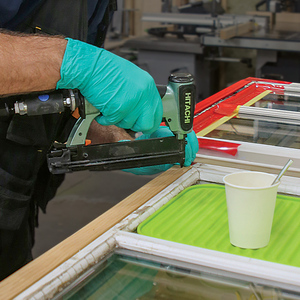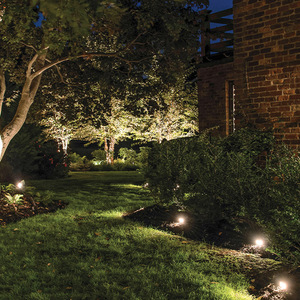The other day I was watching an episode of Dwell. One segment showed how several home introduced what I would call cabinetry-grade plywood for use as a finished wall and or ceiling material. The architecture was modern, which is the premise of the show (I think), and the wood introduction served to soften the other potential cold/harsh nature of modern design.
Has anyone used finished plywood as an interior surface material that wasn’t a workshop? They showed some birch playwood used as a ceiling material and surprisingly it worked well.




















Replies
Ever been to the Mayo Clinic in Rochester. MN?
Full of high grade matched veneer paneling...oak, walnut, birch very nice, almost makes you forget why you were there in the first place.
I used 2'X2' squares of oak plywood layed like big tile for finished floor in sunroom and bedroom. Gets all kinds of positive comments from visitors.
Edited 2/7/2006 9:00 am ET by johnnyd
I once helped install book matched Brazilian rosewood paneling in the conference room of a veneer factor. That was in the mid seventies and the stuff was over $100 per 4x8' sheet then.
I was nervous as a wh*re in church every cut we had to make.
Dave
Nice stuff...in my younger wilder days I worked for awhile in Belize (British Honduras) helping log Rosewood trees, bucking to length, managing a crew that was debarking the trees in preparation to ship them to German and Japanese veneer mills.
We used the bucking off-cuts for firewood. Burned real good. :</
Hey man, could you post a picture of that floor?
Sounds really interesting....also, on the joints did you just but them?
When in doubt, get a bigger hammer!
Process was to first seal both sides of the 4X8 sheets of oak veneer plywood with shellac, then cut the sheets into 24" X 96" strips with a circular saw, then start cutting the squares off on the table saw with a generous side feed table. They ended up something like 22 7/8". Then I put a sanding disc in the table saw tilted at 45° and champfered the upside edges. Since there's just a bit of inaccuracy inherent in the cutting and champfering, I laid the plywood in staggered rows....not corner to corner like most tile.
Then I just sanded with a ROS, and laid on 3 coats of satin poly urethane. That's the stuff in the picture. The ROS was easier to control, probably, than a regular floor sander, as you have to be really careful to not sand through the veneer. I used Waterlox on the other two floors, but really shouldn't have, as the already shellac sealed veneer didn't take up the Waterlox like it should have. Purpose of the shellac in the first place was to make the surfaces resistant to marring from the machining steps, and make final finishing a bit easier.
This was a fairly thick veneer, not nearly as thin as some I got more recently at Home Depot....10 ply, with the top and bottom oak plys about as thick as tissue paper...can really burn through that quick!
Very cool.Dumb question: why chamfer the upside edges? Doesn't this create pockets for dirt? Or am I just reading this wrong?
Well, just envision if you DIDN'T champfer. I used a good blade to make the cut, but not that good, so a dead butt joint wouldn't have looked good. Keep in mind that my machining tolerance was less than perfect...[probably +/- 1/16") Also these are screwed down to the subfloor with four screws each, (holes plugged) so the champfers tend to hide any edge irregularity from THAT operation.
See, one of the purposes of using this system in the first palce was to put down a quick, economical (~$2/sq ft including shellac and poly) finished floor that will serve until a better floor can be financed...hence the four screws per sheet is all that's holding 'em down. But it DOES work so well, that I'll probably never pull them up in my lifetime.
If you do a good job of finishing, those champfer grooves don't attract durt or dust...just sweep with your regular broom.
I suppose if you were convinced that the veneer would wear well enough long term, you could GLUE the squares down.
". . . a dead butt joint wouldn't have looked good."That's what I thought. Since it was a floor application, didn't know if you had experienced any problems.". . . I'll probably never pull them up in my lifetime."I hope not. Too much labor and it looks too good otherwise."If you do a good job of finishing, those champfer grooves don't attract durt or dust...just sweep with your regular broom."They don't clean themselves?! I take back all previous compliments! ;)
Man that does look good....hmm and at 2 bucks a square foot it beats the bargain laminate trash
When in doubt, get a bigger hammer!
Not something that a pro floor guy would probably ever do, but a great DIY project.
I also used some of the same plywood for extension jambs on the windows. When you case it, leave just enough reveal so you can't see the second lamination.
Ok, for doing a wall with plywood did FLW install it over the plaster? Are most folk installing it now over rough taped 1/2 sheetrock? Or is it just being applied to the studs/joists?
for doing a wall with plywood did FLW install it over the plaster?
Oh, no, not even. The entire wall was plywood panels "locked" into milled lumber "connectors" to make a "banded" (horiziontally, of course <wink>) effect. Sometime this was done without studs, as well--for the interior walls.
The FLW details were not in any sort of way "traditional," almost having an "arts & crafts" sort of "if it's used, you can see it" sort of character.Occupational hazard of my occupation not being around (sorry Bubba)
Johnny, I like the end result, but any chance you can provide larger images? I'd like to show the wife that floor. So far, it looks terrific.
BTW, sorry for not participating more in this thread, but it was posted just before I got the Superbowl Flu. :) Then I got busy at work and all. First day I had free, and this responses in this thread are a great morning read. I love the paneling that was done in that foyer. I'm curious if anyone has tried this with a goal of a darker, more red-tone finish.
Ummm, no, that's the way it was saved...I'm a little behind times in technology.
> Has anyone used finished plywood as an interior surface material that wasn't a workshop?
Yes, my father did that in 1971. My mother still lives in that house.
-- J.S.
Has anyone used finished plywood as an interior surface material that wasn't a workshop?
It's done all the time on high-end commercial office space. I recently completed a corporate HQ project that had around $3 million worth of Anigre veneered paneling, doors, frames, and built-ins. The Anigre paneling costs in the neighborhood of $55-60/SF installed. We've also done walnut paneling that cost around $120/SF.
Bob
Very common here in NYC. Used for all kinds of millwork, walls, ceilings even floors.
What is Dwell?
--------------------------
It's only satisfying if you eat it.
Dwell is a fairly hip (in some circles) architecture and design magazine . There website is http://www.dwellmag.com and I'm guessing they have a TV show too.
They tend to focus on prefab housing types and even have a joint venture of sorts with a couple of designers fabricating them as well. This movement has been around in Europe for sometime. I have a copy on my desk now, would lend it to you but...
Dwell is what you are reading if you bought an old rowhouse on the South Side or in the Mexican War streets, and are planning a total gut and rehab, focusing on absolutely modern inside.
The wainscotting in our dining room is plywood, probably 1/4", that's all trimmed with solid wood. For the most part it looks good, but simple. For 1/4" its held up suprisingly well, as the house is 40 years old.
The only objection I have is there's one panel they used that has the "football" in it.
Its shellaced, not painted.
The wainscotting in our family room is cheap unfinished cedar plywood paneling from Menards, stained and varnished. Looks pretty nice, though a few spots were water-stained from the factory (possibly the raw wood was water-stained).It's darn hard to find even semi-nice real-wood paneling anymore, at least at any of the yards around here. I suppose up in the Twin Cities they'd have it somewhere. (Or maybe I could midnight-requisition some from Mayo.)
If ignorance is bliss why aren't more people
happy?
Someone else here used this idea on some cabinets or a countertop or something...Cut a piece of oak or walnut or something into a sutable pattern. A heart, or something else with meaning to the DW. Then rout the same pattern into the plywood where the football is, and inlay your piece of wood.That would be less irritating to look at than the football...
Rudeness is the weak man's imitation of strength. ~~ Eric Hoffer
Luka,
I really like that idea. The football is annoying and its in a place where we can't really put a hutch or something to hide it. I'd be hard to replace the whole panel since its recessed behind all the trim and the finish would be a tough match. An inlay solves all those problems.
Thanks.
You are welcome.Just wish I could think of who it was that suggested it a couple days ago. You could thank them...
Rudeness is the weak man's imitation of strength. ~~ Eric Hoffer
Wife had a decorating book that showed a floor of 2x2 plywood panels with many coats of poly that was beautiful. Lousiana Pacific had the forward cabin bulkhead (wall) of their Gulfstream III out of their OSB. Sanded and finished to a super hi gloss transparent look. It looked awesome.
FLW was a big fan of a similar effect in his Usonian houses (with a boatload of fancy milled shapes & attachments; leaving maybe 5/8" clear for mechanicals--but it looked cool).
One of Frank Lloyd Wright's ideas was to use common materials in an uncommon way -- a technique he used quite a lot in the various Usonians he started designing in the mid-30's.
And using plywood for wall and/or ceiling surfaces was one of the things he did. I saw one of his Usonians (Seth Peterson cottage, outside Madison), where he used plain old fir plywood. But it was done carefully, with a very nice clear varnish finish -- and the overall effect, I thought at least, was pretty terrific.
I utilized this concept a few years back in using MDF (cut to 4' X 4') for flooring material in a third floor attic restoration, laid on the diagonal to the exterior walls. We ran maple strips between the sheets (for an inlay effect), then sanded/varnished the floor in the conventional manner. I think FLW would have been pleased with the result.
********************************************************
"It is what we learn after we think we know it all, that counts."
John Wooden 1910-
where he used plain old fir plywood. But it was done carefully, with a very nice clear varnish finish
Hmm, my book on FLW's Usonians suggests that FLW only wanted things like fumed oak and the like--it was up to the "apprentice" sent to the actual site to sort out (with the GC) what actual materials were used in completing the couple of pages of "standard" details (which omitted all mention of material & finish).
O, for the "good ol' days" . . . <cringe>Occupational hazard of my occupation not being around (sorry Bubba)
Our design headquarters has plywood and galvanized corrugated steel sheets as interior wall surfaces. Looks good, though it'd be a long stretch to do the corrugated in a residential setting.
did
I was in an upscale studio apartment in New Haven, CT last year that had partion walls dividing up the living space. And they used veneered plywood as a decorative cover on the partitions - with maybe a half inch between sheets as a shadow line. It was interesting, but not my cup of tea.
...the flooring idea is interesting though, except for when it comes to sanding and refinishing.
Justin Fink - FHB Editorial
All the wainscoting in this foyer is made from oak veneer plywood edgebanded before running stile and rail through the shaper for tongue and groove and then 1/4" veneer ply panels
Smaller photos attached (if a file is larger than 100kb or so, most won't open them to look at em)
Great work! What's normally hanging from the closet rod that goes in front of the window?
We had a big party so I put up a closet rod for coats. After I just puttied the screw holes. I was thinking of putting up a couple of corbels for something more permanent